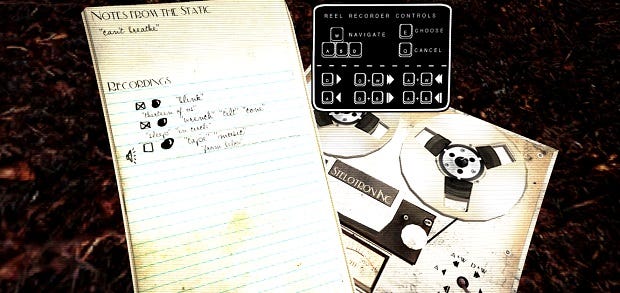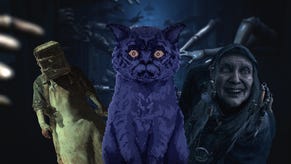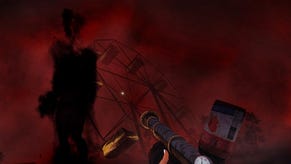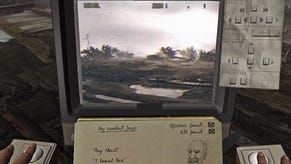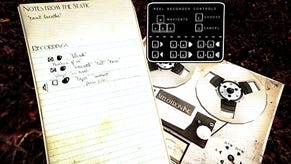Wot I Think: Sylvio
Phenomenal
Horror fans are poorly served and many, myself included, are gluttons for punishment. I try so many Slender-likes hoping to find a creepy idea or one good scare. It's the same in film as in games – I soak up exorcisms and found footage hoping to be spooked or unnerved, and usually walk away disappointed or disgusted.
It makes me very happy to say that recently released indie ghost hunting scare 'em up Sylvio [official site] is an imaginative, unusual and frightening new horror game. Here's wot I think.
Electronic voice phenomena are the central concern of Sylvio. Otherworldly audio recordings are a focus so obvious for a horror game that I'm surprised nobody has successfully implemented them before. On one level, the chopped up, static-haunted whispers and cries in the dark are creepy versions of audio logs, which have become one the go-to structural components of narrative in games – novels have sentences, paragraphs and chapters; games have audio logs and bloody graffiti.
Sylvio's levels contain basic inventory puzzles, some backtracking across small and sensible areas, the occasional spot of shooting (although it's not as intrusive as the verb suggests), and plenty of clues and other collectibles. Holding it all together are the recordings, which are sometimes in the form of actual tape reels but are more often captured from beyond following a ghostly manifestation. Those manifestations come in four basic forms – benign white orbs that scratch a few words into the ether, dangerous black gloopy blobs that home in on you and bursts into sinister noise, weird distressed humanoid forms, and stationary spirits that communicate through question and answer séances.
Brilliantly, Sylvio makes all but the most basic white orb recordings actual things to be manipulated. You collect them and then you analyse them rather than simply listening to a scripted sequence in which they're deciphered. Using an old reel to reel system, you're able to run each recording forward or backward at three speeds, skimming through the white noise to find recognisable sounds, then working through the distortions to pick out words and phrases.
Once you've played a section at the right speed and in the right direction, the phrase is automatically added to your notebook and (inexplicably) a marker appears in the world, pointing to the object referred to. At first, I thought those HUD markers were too much of a shortcut, a convenience that doesn't fit with the player character's situation or abilities, but it didn't take me long to accept the helping hand. Sylvio's environments aren't the most attractive you'll ever see and without the on-screen help, you'd spend hours staring at muddy textures, searching for buttons and levers. The guidance provided ensures the mood doesn't dip into frustration and that you're always moving forward.
And you'll want to. The audio recordings are excellent, the exploration and puzzling is satisfactory if basic, and the central mysteries of the game are horribly unpleasant. As is often the case in horror, the uncanniness and terror threatens to dissipate as the story comes closer to revelations, and the murk and shadows are pushed back, but Sylvio retains a certain weird off-kilter sensibility even as it shows its hand.
That's partly because the EVP method of delivery deals in fragments. When you're standing in the woods late at night analysing a sound file that contains a tormented voice murmuring something about not being able to breathe and endless tunnels BACKWARDS, that's exposition enough to send a shiver down your spine. Playing at night wearing headphones, I've been driven under the duvet by Sylvio and, impressively, it mostly gets by without throwing any direct threats in your face. At its best it's a game that implies horrors, through both its audio and the slow reveal of its intertwined tales, and hearing the word “Honolulu” in an otherwise quiet corner of the map caused me to flinch at one point. There is weight in the words.
There's also a bobbins car, seemingly borrowed from Deadly Premonition, and a shotgun (more like a blunderbuss in practice) that shoots spuds and nails. Yes, the game refers to them as spuds. They're used very infrequently to trigger physical interactions on distant objects. Need to dislodge a wheel that's out of reach? Fire a potato at it.
The nails are used to disrupt the physical manifestations of spirits and that's where I thought the game might fall down. In practice, it's a distraction from the game's best moments but one that works, if barely. The black goo doesn't look particularly threatening and in the first couple of levels, when it looms through corridors and claustrophobic rooms, it all seems a bit silly. Later, when the areas you're exploring are more open and you find yourself in the oddly red-tinged outdoors, there's something oppressive about the arrival of the blobs. It's tied to the sound again – your mic picks up all sorts of distortion and lets you know how far away they are and I found myself scanning the treeline for a sight of them, backing away and panicking.
It doesn't become a shooting gallery at any point – they're slow, solitary and move directly toward you at all times – and each entity has a specific audio file attached rather than being a generic “monster”. The shotgun still feels out of place, particularly in those early stages, but it's not as worrisome as it seemed in the first trailer for the game.
I've barely mentioned the story because it's best to go in cold. It's slightly jumbled, the threads snagging on occasional dead-ends and unnecessary diversions, and the parts are greater than the whole, but it spooked me and left me satisfied. It doesn't overstay its welcome either, which sometimes seems like the game critic's equivalent of calling a London flat with the toilet next to the bed “cosy”. Not in this case. Run through quickly, knowing what to do, and it's a very short game indeed, but exploring and figuring everything out will take at least six hours. I spent ten, although I was taking my sweet time (and hiding under the duvet).
My one big complaint is that there's no way to manage save games. The autosave doesn't register at anywhere near enough checkpoints and if you start a new game, you'll lose all your progress. Boo. Hopefully that will change in an update – the developer has already added an inverted y axis option after people requested it.
I almost walked away during the opening moments, when Sylvio seems like yet another cobbled together mess of repetitive graphical assets. I figured I'd play until the first jump scare and then quit. Instead, I found a game that uses its limited resources to find clever ways to scare the life out of me. It's a quiet horror game – an anti-screamer, right down to the calm almost-whispers of the protagonist – and it's a triumph.
